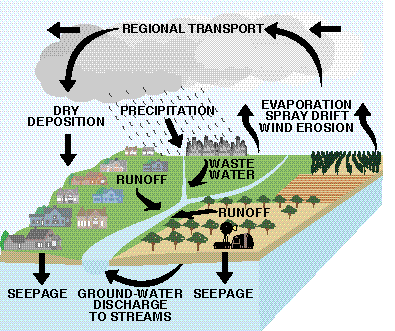Pesticides in the Atmosphere
U.S. Geological Survey, Fact Sheet FS-152-95
Pesticides in the Hydrologic System
More than 600 million pounds of pesticides are used each
year in the United States to control many different types of
weeds, insects, and other pests in a wide variety of agricultural
and urban settings. National use of herbicides and insecticides
on cropland and pasture has grown from 190 million pounds of
active ingredient in 1964, to an estimated 630 million pounds in
1988. Though increased use has resulted in increased crop
production and other benefits, concerns about the potential adverse
effects of pesticides on the environment and human health have
grown steadily.

Figure 1. Pathways of pesticide movement in the hydrologic cycle.
Importance of the Atmosphere
In many respects, the greatest potential for adverse effects of
pesticides is through contamination of the hydrologic system,
which supports not only human life, but aquatic life and related
food chains as well. Water is one of the primary means by which
pesticides are transported from their application areas to other
parts of the environment. Thus, there is potential for movement
of pesticides into and through all components of the hydrologic
cycle (see Figure 1).
Back - Next
